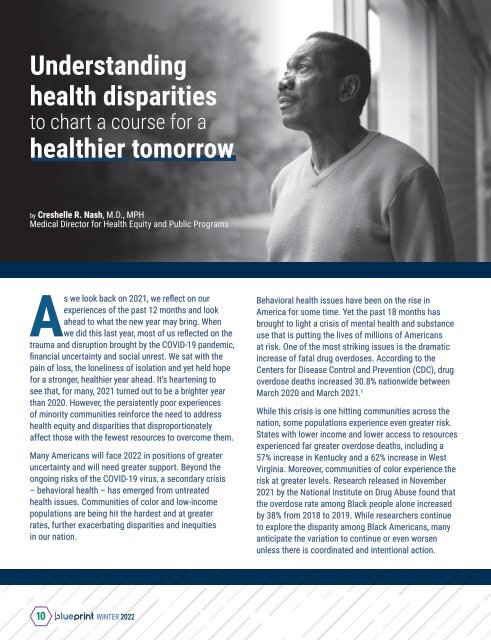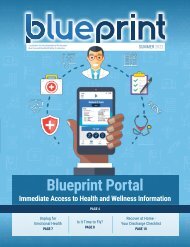Blueprint Winter 2022
You also want an ePaper? Increase the reach of your titles
YUMPU automatically turns print PDFs into web optimized ePapers that Google loves.
Understanding<br />
health disparities<br />
to chart a course for a<br />
healthier tomorrow<br />
by Creshelle R. Nash, M.D., MPH<br />
Medical Director for Health Equity and Public Programs<br />
As we look back on 2021, we reflect on our<br />
experiences of the past 12 months and look<br />
ahead to what the new year may bring. When<br />
we did this last year, most of us reflected on the<br />
trauma and disruption brought by the COVID-19 pandemic,<br />
financial uncertainty and social unrest. We sat with the<br />
pain of loss, the loneliness of isolation and yet held hope<br />
for a stronger, healthier year ahead. It’s heartening to<br />
see that, for many, 2021 turned out to be a brighter year<br />
than 2020. However, the persistently poor experiences<br />
of minority communities reinforce the need to address<br />
health equity and disparities that disproportionately<br />
affect those with the fewest resources to overcome them.<br />
Many Americans will face <strong>2022</strong> in positions of greater<br />
uncertainty and will need greater support. Beyond the<br />
ongoing risks of the COVID-19 virus, a secondary crisis<br />
– behavioral health – has emerged from untreated<br />
health issues. Communities of color and low-income<br />
populations are being hit the hardest and at greater<br />
rates, further exacerbating disparities and inequities<br />
in our nation.<br />
Behavioral health issues have been on the rise in<br />
America for some time. Yet the past 18 months has<br />
brought to light a crisis of mental health and substance<br />
use that is putting the lives of millions of Americans<br />
at risk. One of the most striking issues is the dramatic<br />
increase of fatal drug overdoses. According to the<br />
Centers for Disease Control and Prevention (CDC), drug<br />
overdose deaths increased 30.8% nationwide between<br />
March 2020 and March 2021. 1<br />
While this crisis is one hitting communities across the<br />
nation, some populations experience even greater risk.<br />
States with lower income and lower access to resources<br />
experienced far greater overdose deaths, including a<br />
57% increase in Kentucky and a 62% increase in West<br />
Virginia. Moreover, communities of color experience the<br />
risk at greater levels. Research released in November<br />
2021 by the National Institute on Drug Abuse found that<br />
the overdose rate among Black people alone increased<br />
by 38% from 2018 to 2019. While researchers continue<br />
to explore the disparity among Black Americans, many<br />
anticipate the variation to continue or even worsen<br />
unless there is coordinated and intentional action.<br />
10 WINTER <strong>2022</strong>

















